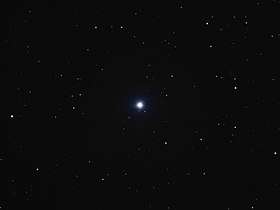Sigma Herculis
Sigma Herculis, Latinized from σ Her, is a binary star[7] system in the northern constellation of Hercules. It has a combined apparent visual magnitude of 4.18,[2] making it bright enough to be visible to the naked eye. Based upon an annual parallax shift of 10.36 mas as seen from Earth, Sigma Herculis is located about 310 light years away from the Sun.[1]
 σ Herculis in optical light | |
| Observation data Epoch J2000.0 Equinox J2000.0 (ICRS) | |
|---|---|
| Constellation | Hercules |
| Right ascension | 16h 34m 06.18334s[1] |
| Declination | +42° 26′ 13.3455″[1] |
| Apparent magnitude (V) | 4.18[2] (4.20 + 7.70)[3] |
| Characteristics | |
| Spectral type | B9 V[4] (B7 + A9)[3] |
| U−B color index | −0.14[2] |
| B−V color index | −0.03[2] |
| Astrometry | |
| Radial velocity (Rv) | −10.90±1.78[5] km/s |
| Proper motion (μ) | RA: −7.54[1] mas/yr Dec.: +59.42[1] mas/yr |
| Parallax (π) | 10.36 ± 0.46[1] mas |
| Distance | 310 ± 10 ly (97 ± 4 pc) |
| Absolute magnitude (MV) | −0.72[6] |
| Orbit[7] | |
| Period (P) | 2,706.19±4.89 d |
| Semi-major axis (a) | 0.07621±0.00027″ |
| Eccentricity (e) | 0.5135±0.0028 |
| Inclination (i) | 105.25±0.51° |
| Longitude of the node (Ω) | 14.95±0.47° |
| Periastron epoch (T) | 50665.4 ± 2.68 |
| Argument of periastron (ω) (secondary) | 184.97±0.40° |
| Details | |
| σ Her A | |
| Mass | 2.60[8] M☉ |
| Radius | 4.91[9] R☉ |
| Luminosity | 230[4] L☉ |
| Surface gravity (log g) | 3.78±0.14[8] cgs |
| Temperature | 9,794±333[8] K |
| Rotational velocity (v sin i) | 280[10] km/s |
| Age | 404[8] Myr |
| σ Her B | |
| Mass | 1.5±0.5[4] M☉ |
| Luminosity | 7.4[4] L☉ |
| Other designations | |
| Database references | |
| SIMBAD | data |
The components of this binary system have a separation of 7 AU,[4] and are orbiting their common barycenter with a period of 7.4 years and an eccentricity of 0.5.[7] The primary, component A, is magnitude 4.20[3] B-type main sequence star with a stellar classification of B9 V.[4] At an age of around 404 million years,[8] it is spinning rapidly with a projected rotational velocity of 280 km/s. This is giving the star an oblate shape with an equatorial bulge that is an estimated 18% larger than the polar radius.[10] The star has an estimated 2.60 times the mass of the Sun,[8] 4.91 times the Sun's radius,[9] and is radiating 230[4] times the solar luminosity from its photosphere at an effective temperature of 9,794 K.[8]
The primary is emitting an infrared excess, suggesting the presence of an orbiting debris disk with a temperature of 80 K located at a radius of 157 AU.[9] There may be a second disk orbiting between 7 and 30 AU with a temperature of 300±100. The Poynting–Robertson lifetime of the dust grains in this inner belt is around 46,000 years − much less than the age of the star. Hence the grains are being replenished, presumably through collisions between larger objects.[4] Circumstellar gas is visible in ultraviolet images from the FUSE satellite, which is likely being emitted by the circumstellar matter then driven outward by the star's radiation.[4]
The secondary, component B, has a magnitude of 7.70 and is an A-type main-sequence star.[3] It has around 1.5 times the mass of the Sun and 7.4 times the Sun's luminosity.[4]
References
- van Leeuwen, F. (2007), "Validation of the new Hipparcos reduction", Astronomy and Astrophysics, 474 (2): 653–664, arXiv:0708.1752, Bibcode:2007A&A...474..653V, doi:10.1051/0004-6361:20078357.
- Mermilliod, J.-C. (1986), "Compilation of Eggen's UBV data, transformed to UBV (unpublished)", Catalogue of Eggen's UBV Data, SIMBAD, Bibcode:1986EgUBV........0M.
- Cvetkovic, Z.; Ninkovic, S. (2010), "On the Component Masses of Visual Binaries", Serbian Astronomical Journal, 180: 71–80, Bibcode:2010SerAJ.180...71C, doi:10.2298/SAJ1080071C.
- Chen, C. H.; Jura, M. (January 2003), "The Low-Velocity Wind from the Circumstellar Matter around the B9 V Star sigma Herculis", The Astrophysical Journal, 582: 443–448, arXiv:astro-ph/0209076, Bibcode:2003ApJ...582..443C, doi:10.1086/344589.
- de Bruijne, J. H. J.; Eilers, A.-C. (October 2012), "Radial velocities for the HIPPARCOS-Gaia Hundred-Thousand-Proper-Motion project", Astronomy & Astrophysics, 546: 14, arXiv:1208.3048, Bibcode:2012A&A...546A..61D, doi:10.1051/0004-6361/201219219, A61.
- Anderson, E.; Francis, Ch. (2012), "XHIP: An extended hipparcos compilation", Astronomy Letters, 38 (5): 331, arXiv:1108.4971, Bibcode:2012AstL...38..331A, doi:10.1134/S1063773712050015.
- Hutter, D. J.; et al. (November 2016), "Surveying the Bright Stars by Optical Interferometry. I. A Search for Multiplicity among Stars of Spectral Types F-K", The Astrophysical Journal Supplement Series, 227: 4, arXiv:1609.05254, Bibcode:2016ApJS..227....4H, doi:10.3847/0067-0049/227/1/4.
- David, Trevor J.; Hillenbrand, Lynne A. (May 2015), "The Ages of Early-type Stars: Strömgren Photometric Methods Calibrated, Validated, Tested, and Applied to Hosts and Prospective Hosts of Directly Imaged Exoplanets", The Astrophysical Journal, 804: 146, arXiv:1501.03154, Bibcode:2015ApJ...804..146D, doi:10.1088/0004-637X/804/2/146.
- Rhee, Joseph H.; et al. (May 2007), "Characterization of Dusty Debris Disks: The IRAS and Hipparcos Catalogs", The Astrophysical Journal, 660 (2): 1556–1571, arXiv:astro-ph/0609555, Bibcode:2007ApJ...660.1556R, doi:10.1086/509912.
- Belle, G. T. (2012), "Interferometric observations of rapidly rotating stars", The Astronomy and Astrophysics Review, 20: 51, arXiv:1204.2572, Bibcode:2012A&ARv..20...51V, doi:10.1007/s00159-012-0051-2.
- "sig Her". SIMBAD. Centre de données astronomiques de Strasbourg. Retrieved 2017-04-05.